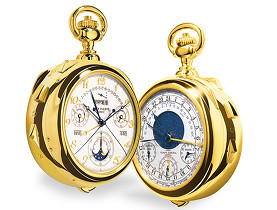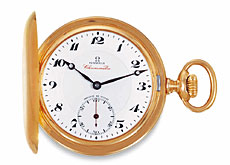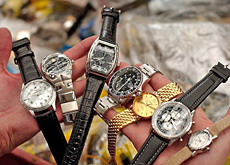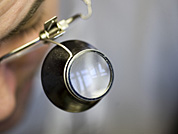Breaking records like clockwork

It is not the most expensive timepiece but the Calibre 89 by watchmaker Patek Philippe of Geneva is the most intricate instrument of its kind in the world.
“It has pretty much all the complications that you can imagine for a mechanical watch,” says Jean-Michael Piguet, deputy curator of the International Watchmaking Museum in La Chaux-de-Fonds, a Swiss town near the French border.
The Calibre 89 was designed to celebrate the watchmaker’s 150th anniversary in 1989. It is an example of Swiss watchmaking at its very best and one of the finest that the legendary Geneva-based company has ever produced.
It is hardly a pocket watch. At 9cm in diameter, 4cm thick and weighing 1.1kg, it functions with a traditional mechanical movement, encased in precious metal.
It contains hundreds of bridges, gears, pivots, pinions, pins, tiny screws and springs – a total of 1,728 parts.
In 2004 the Antiquorum auction house sold a white gold Calibre 89 for just over $5 million (SFr6.6 million at the time).
That sum pales in comparison to another Patek Philippe creation – a compact piece for banker Henry Graves Jr., technically almost as rich and complex as the Calibre 89 but more than half a century older, sold at Sotheby’s in 1999 for over $11 million.
Mechanical precision
Most watches and clocks today are electronic – they use a quartz crystal, which is considered more accurate than mechanical movements – but high-end timepieces are still made with micromechanical precision and are the dream of aficionados.
A reasonably good mechanical watch is able to display hours, minutes and seconds. A more complicated piece incorporates other functions like a striking mechanism and a stopwatch, and can show the date and the phases of the moon.
The Calibre 89 features a record 33 of these different types of functions, or complications. It will tell you when the sun rises and sets in Geneva, the current month, year, decade, century and phase of the moon. It also has two different striking mechanisms.
It incorporates the Georgian calendar, a map of the sky as seen from Geneva and the date of the next Easter, which appears each December 31. All of this is displayed with the help of two dials, eight discs and 24 hands.
It sounds audacious but the company began the project with the goal of making “the clock with the most complications in the world, containing all the traditional watchmaking techniques accumulated over one-and-a-half centuries.”
Some of the complications had never been published. The personal notes and drawings of Patek Philippe engineer Jean-Pierre Musy proved an invaluable source of knowledge.
16th Century roots
The company will not divulge how much it invested in the Calibre 89. But it is willing to say that the entire project took nine engineers and watchmakers five years for research and development and another four years for production – without the help of computers.
All of its 1,728 parts were hand finished and then assembled. Watchmakers repeatedly assembled and disassembled the Calibre 89 until everything worked flawlessly.
“Given the expertise of watchmakers and the technical resources for production, it would have been difficult if not impossible to build such a complex watch 100 years ago,” company spokeswoman Isabell Ferch told swissinfo.ch.
The timepiece nevertheless reflects the accumulation of knowledge over centuries of watchmaking. Its roots go back to the 16th century, when the first mechanical watches with complications started being produced.
Cheap electronics can do much more, much faster and much cheaper but that is beside the point. The Calibre 89 is a piece for the well-heeled. Collectors are discreet and so is the company.
It is rumoured that a single collector at one time owned all four Calibre 89 watches ever produced – one in white gold, one in yellow gold, one in rose gold and one in platinum.
Pierre-François Besson, swissinfo.ch (Adapted from French by Justin Häne)
With 1,300 employees, Patek Philippe manufactures 40,000 watches a year. Three-quarters are mechanical.
The company was founded in 1839 by a pair of Polish immigrants, one of whom was Antoine Norbert de Patek. In 1844 they were joined by Frenchman Adrien Philippe, and the following year Patek’s partner left.
The company changed its name to Patek Philippe & Cie in 1851.
In the 1930s, it was sold to the Stern family, which continues to operate the business.
Patek Philippe enjoys a high degree of prestige in the watchmaking world.
It holds dozens of patents for complications, including a perpetual calendar – i.e. which takes into account not only the different number of days in the months but also leap years.
Beginnings: The watchmaking industry in Geneva was established in the mid-17th century, and later spread to the neighbouring Jura region.
Complications:: Any function other than the indication of hours, minutes and seconds is called a complication. The earliest complications – striking mechanisms and astronomical information – go back to the 15th century and predate both the minute and the second hand. More and more complications have been added in modern times.
Quartz: In the 1970s Swiss watchmakers failed to capitalise on the quartz revolution, which enabled millions to own a watch who could not afford a mechanical piece. Overseas competition led to a crisis which nearly destroyed the industry.
Hayek: Business consultant Nicolas G. Hayek, chairman of the Swatch Group, is credited with rescuing the Swiss watchmaking by helping to promote cheap and cheerful watches as a fashion accessory.
Jobs: Today, the Swiss watch industry exports goods worth SFr17 billion. In 1986 exports were worth SFr4.3 billion. Before the quartz revolution, the Swiss industry employed 90,000 people. That number fell to 30,000 before rising to around 50,000 today.

In compliance with the JTI standards
More: SWI swissinfo.ch certified by the Journalism Trust Initiative












You can find an overview of ongoing debates with our journalists here . Please join us!
If you want to start a conversation about a topic raised in this article or want to report factual errors, email us at english@swissinfo.ch.